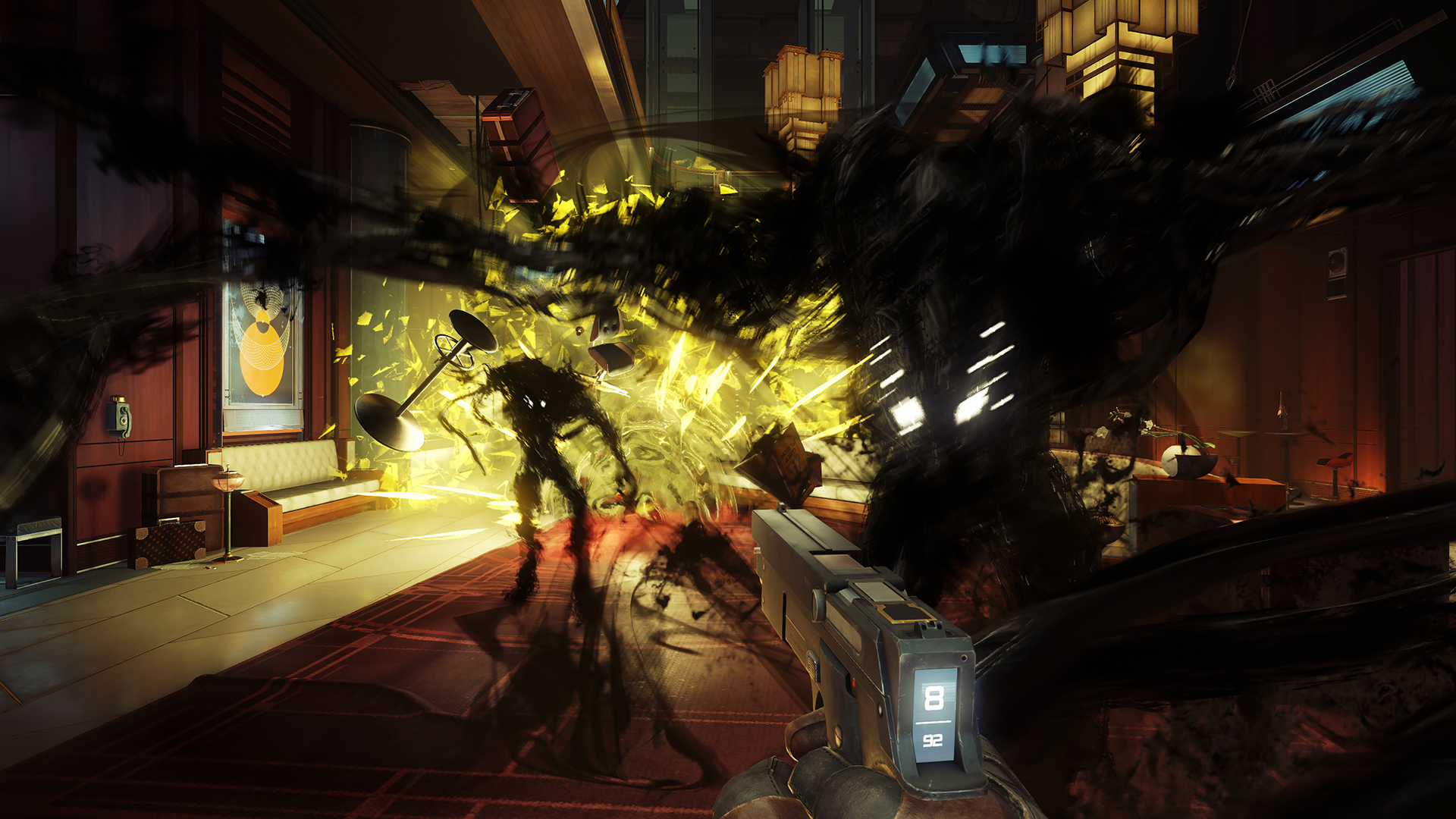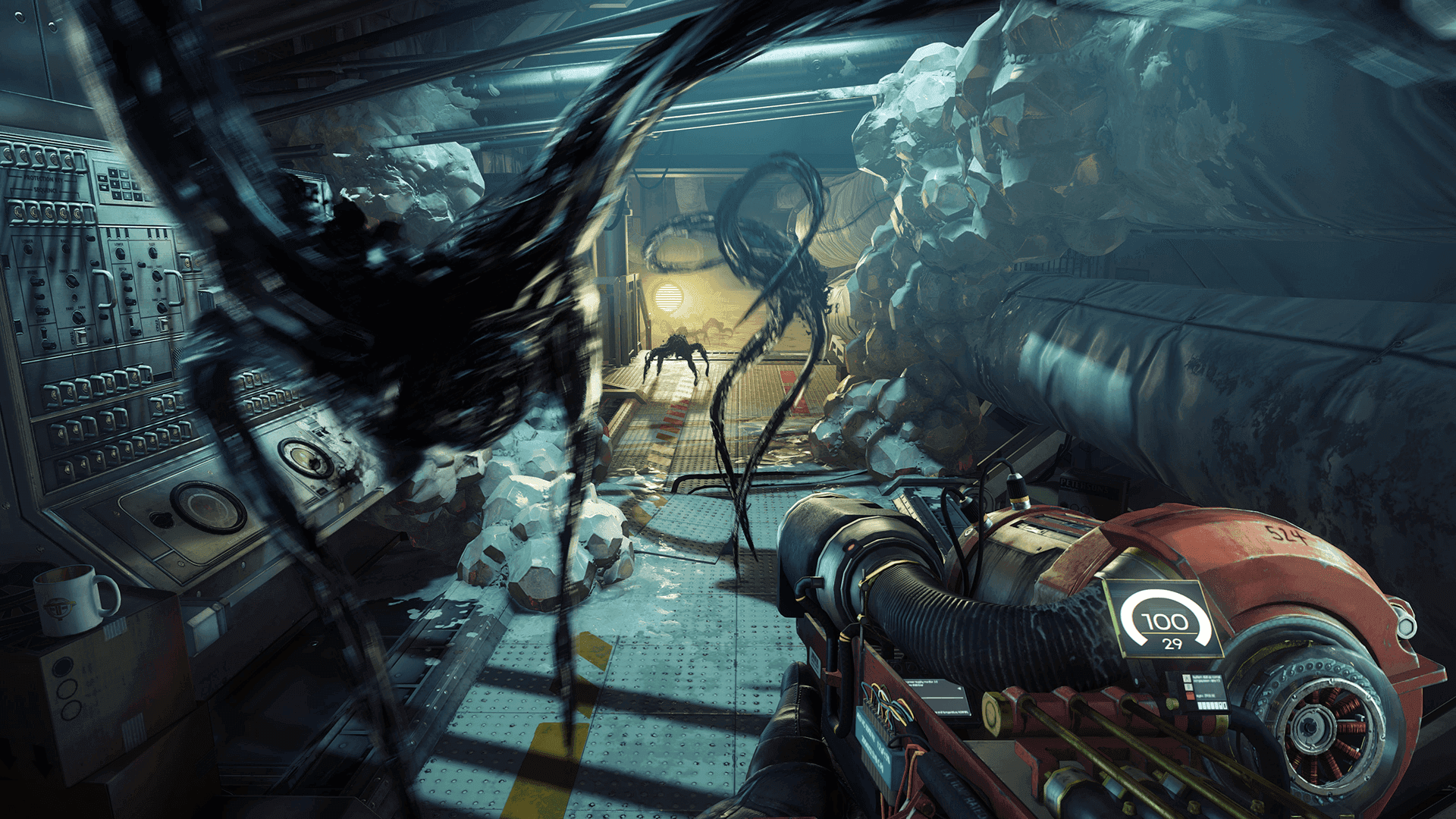Search
[{{{type}}}] {{{reason}}}
{{/data.error.root_cause}}{{{_source.title}}} {{#_source.showPrice}} {{{_source.displayPrice}}} {{/_source.showPrice}}
{{#_source.showLink}} {{/_source.showLink}} {{#_source.showDate}}{{{_source.displayDate}}}
{{/_source.showDate}}{{{_source.description}}}
{{#_source.additionalInfo}}{{#_source.additionalFields}} {{#title}} {{{label}}}: {{{title}}} {{/title}} {{/_source.additionalFields}}
{{/_source.additionalInfo}}- Details
- Category: PlayStation 4
- By Sam George
- Hits: 4270
Prey (2017) (PS4)

Prey (2017)
Developed by: Arkane Studios
Published by: Bethesda
Release date: May 5, 2017
Available on: PlayStation 4, PC, Xbox One
Genre: First-person shooter (Immersive Sim)
Number of players: Single player
ESRB Rating: M for Blood, Language, Use of Alcohol, Violence
Price: $19.99
It has been a while since the first immersive sim games like System Shock and Deus Ex. Worlds were more pixelated, but also more open. Stories had to be pieced together for the sake of depth and complexity. Sometimes the player could make a character build unable to progress further, having not recognized the importance of combat or crafting on a space station overrun with violent enemies. Often, due to technical constraints, the story was told largely through text and voice recordings and needed to be written to account for this. Prey suggests that these sensibilities can work decades later. A combination of throwback and modern shooter, it succeeds brilliantly. On the surface, Prey is more similar to System Shock than Bioshock and Dishonored could hope to be - space station, evil corporate experimentation leading to infectious enemies, paranoia, resource allocation, human enhancement, and computerized guiding voices. Yet Prey is also a game about a theme to which it commits in every quest, environment, and sidestory. What can be given up to save the many, or the one? What will you do to help people, and at what cost?
Prey has a twist opening, so I’ll skip to the point: the player controls Morgan Yu, either the brother or sister of the CEO of a research company operating the Talos I space station. I chose to play as a female Morgan. Morgan is trapped on the station with a huge gap in her memory, surrounded by an alien threat called the Typhon. The player’s goal is...well, that’s the point I tried to make earlier. The story branches quickly, with characters insisting it is Morgan’s responsibility to destroy Talos I with the Typhon and herself aboard. They contrast the characters who insist on a responsibility to escape to warn humanity. Others claim the station must be saved to salvage the research trapped inside. Morgan is not forced to act on any one person’s orders. In fact, she can kill anyone who does give her an order. But whatever goal the player decides to pursue, they must make it happen within the game itself. Want to escape? You better find a working escape pod. Want to detonate the station? Your brother the CEO isn’t keen on that and will try to stop you. Choose who to work with or go it alone; Prey will demand exploration and backtracking to open up options.
Prey’s openness extends to level design. Though progression from area to area is mostly linear, movement within them is organic and open. Maintenance shafts, security panels, shelving, cabinets, and enemies all might hinder certain paths. The player, especially early on, must choose how they want Morgan to solve these problems because progression through the skill tree is tightly regulated, and points put into hacking are not being used for survivability or repair. In some ways this makes navigation far easier than it would be if the game insisted on combat. Viable as a combat build is, crawling through the walls is usually possible with a bit of awareness and patience. I accidentally picked up valuable quest and upgrade items just from poking around non-essential rooms.

Strong Points: Level design encourages a variety of approaches; choice-heavy quests rely on gameplay rather than binary decisions; thematic story and sidequests; lots of worldbuilding detail for its own sake; varied character build possibilities
Weak Points: Uneven difficulty can lead to unworkable character builds and inventory starvation; buggy quest triggers; frequent load screens
Moral Warnings: Gun and melee violence against aliens and machines; blood, missing body parts, and corpses of humans regularly shown; violence against humans is possible and occasionally encouraged; R-rated swearing throughout; alcohol drunk by characters and by the player for gameplay benefits; multiple homosexual relationships referred to
Much of the game is non-essential, and I mean that in the best way. Talos I has bathrooms, lots of them. It’s an advanced space station with hundreds of staff; of course it needs bathrooms. There’s a museum room where (if you can kill/subdue the resident Typhon) you can learn about the alternate history that predates the events of the game. Every dead body has a name, many of which match a specific workstation and a specific bedroom, all of which Morgan can explore. Audio logs tell the interested player not just what evil things have been going on but what certain employees did as collaborators or resistance. There was an ongoing tabletop roleplaying game interrupted by the alien trouble, and I visited the room the game took place in, dice still on the table. The graphics sell the realism of the environment if not always of the human characters. Talos I feels like a place people actually lived in.
By the time the game starts, Talos I isn’t so inhabitable anymore. The Typhon cover the station, even if you can’t see them. The most basic enemy, small spider-like creatures called mimics, live up to their name. They take the form of everyday objects like chairs, coffee cups, and first-aid kits. Two chairs sitting next to each other might be just that, or one might be a mimic ready to pounce. The player cannot trust the environment and must stay alert to scurrying and flashing lights. While Prey doesn’t feel like a horror experience, it induces paranoia everywhere. Larger enemies are less interesting but more dangerous. A variety of vulnerabilities and resistances ensure the player carefully curates Morgan’s limited inventory space. The game is more about planning for encounters than skillfully fighting, and taking your time will pay off more than rushing into battle.
Between the shooting, healing, and hiding, Morgan’s resources are always low. Sporadic recyclers and synthesizers let Morgan turn environmental trash into useful items. You must do this diligently to keep up with the constant drain exploration puts on your supplies. There is not an endless amount of resources, and it is theoretically possible to burn through so much that the melee wrench is not enough to get the player through. I appreciated the tension, although it is not everyone’s cup of tea. Prey does not want you to feel empowered. It was a pain to be low on ammunition all the time if only because the shotgun felt so good to use. A whole branch of alien enhancements is available to the player as well, including mind control, telekinesis, and fire. They use up a limited mana pool, so leaning into these abilities is choosing one form of resource management over another.

Higher is better
(10/10 is perfect)
Game Score - 90%
Gameplay - 19/20
Graphics - 8/10
Sound - 10/10
Stability - 3/5
Controls - 5/5
Morality Score - 44%
Violence - 0/10
Language - 0/10
Sexual Content - 6/10
Occult/Supernatural - 10/10
Cultural/Moral/Ethical - 6/10
There are so many gameplay systems here. There’s the inevitable-yet-brief hacking minigames. Prey manages decent zero-gravity controls for extravehicular activity. There’s the GLOO Cannon, which immobilizes enemies and builds footholds on walls. It all works. What doesn’t always work is the quest triggering, especially when other humans are on-screen. It was about 20 hours in when the game didn’t recognize that I’d taken a character into a certain area. I figured out how to convince the game I’d completed the quest, but I shouldn’t have had to. These bugs are not unknown and seem to not be rare for other players. Broken quest lines are a big issue where they come up; fortunately, they rarely did.
Talos I is fittingly filled with bloody and decaying bodies. At one time I was encouraged to shoot an unconscious man in the head. If you want to know why I did, you should play the game. That might be the only time the game encouraged that kind of action explicitly, but Morgan is free to save or kill every surviving human and still complete the game. Often the player is forced into an either-or situation: attempt to save a few or be guaranteed to save a different, more numerous group. Many times the player has to weigh the threat of the Typhon to humanity against their threat to people in the room. Prey doesn’t force killing per se, but it does force decisions where action or inaction will influence others’ fates. Also, you can’t change the backstory or the actions of others. As such there is alcohol strewn across the station which the player can consume. Talos I is home to horrific human experiments the player can observe and, to an extent, take part in. One side arc follows the romantic relationship between two female crewmembers. Morgan herself (or himself) had a relationship with a female coworker before the events of the game. Among audiotapes and dialog there is much swearing from f*** to undue references to God. Typically the swearing regards the swearers’ place of business being overrun by carnivorous aliens. I’d deem it unnecessary yet not unrealistic.
If the description of an immersive sim sounds fun and M-rated content is acceptable, Prey is the modern option you want. It has a deep world and many toys with which to play. It is plain good sci-fi joined to demanding resource gameplay. I loved the natural presentation of its moral quandaries, and the gameplay kept my attention despite me usually not having a taste for shooters. Prey hits a niche which games haven’t quite filled for a long time.








